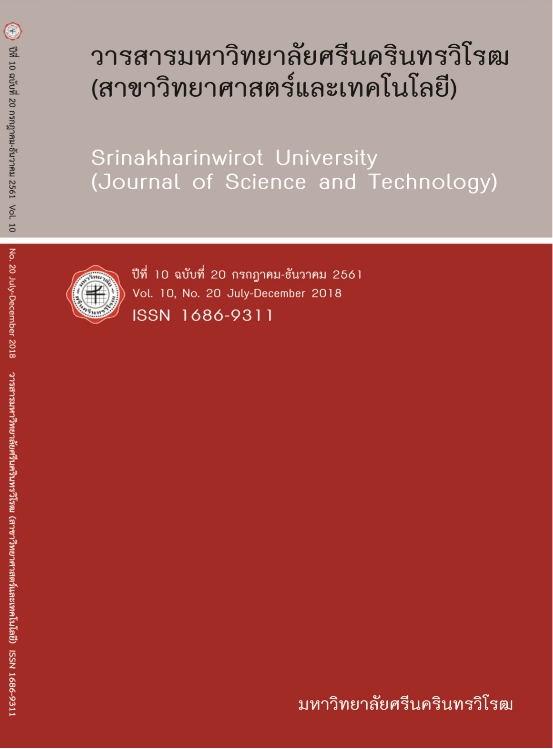ความสัมพันธ์ของการทรงตัวระหว่างแนวแกนร่างกายกับค่าจุดศูนย์กลางแรงดันในกลุ่มการสบฟันประเภทต่างๆ RELATIONSHIP BETWEEN BODY POSTURE, BODY AXIS AND THE CENTER OF PRESSURE IN DIFFERENT OCCLUSIONS
Keywords:
Camera Positioning, Force Plate, Reflective Marker, Center of PressureAbstract
Introduction: According to previous studies, untreated diseases of the stomatognathic system may cause significant changes in body posture, stability, and gait. Thus, the correction of malocclusions provide patients with numerous benefits, such as aesthetic improvements in terms of chewing function and oral health. This study was designed to evaluate the relationship between body posture, body axis and the center of pressure in different occlusions.
Material and Methods: There were twenty-four subjects divided into three groups of eight based on occlusion types and Angle’s classification. Group One was assigned to Class One; Group Two was assigned to Class Two; Group Three was assigned to Class Three. Body posture was on an anteroposterior and a bilateral axis and was recorded using camera positioning for axis movement in terms of degree and a force plate for maximum and minimum amplitude values of the center of pressure in twenty seconds. The data obtained was subject to statistical analysis using the Pearson correlation and with a result of p≤0.05, it was considered significant.
Results: In the anteroposterior axis, groups one, two and three showed Pearson correlation and p-values of 0.710:0.048, 0.182:0.665 and 0.699:0.054, respectively. On the bilateral axis, groups one, two and three showed Pearson correlation and p-values of 0.604:0.113, 0.610:0.108 and 0.682:0.062, respectively. The assessment of the overall body movement showed that subjects in group 1 2 and 3 had acceptable postural stability but only subjects in group 1 showed statistically significant of postural stability in anteroposterior axis and linear equation is y = 2.78x + 14.88.
Conclusions: This study demonstrated that the relationship between body posture, the body axis and the center of pressure in three occlusions. These results could lead to and improve the creation of effective instruments for body axis assessment and replace the equipment currently used to assess body stability.
Downloads
References
[2] Shimazaki T, Motoyoshi M, Hosoi K; and Namura S. (2003). The effect of occlusal alteration and masticatory imbalance on the cervical spine. Eur J Orthod. 25: 457-463.
[3] Michelotti A, Buonocore G, Manzo P, Pellegrino G; and Farella M. (2011). Dental occlusion and posture: an overview. Prog Orthod. 12(1): 53-58.
[4] Wakano S, Takeda T, Nakajima K, Kurokawa K; and Ishigami K. (2011). Effect of experimental horizontal mandibular deviation on dynamic balance. J Prosthodont Res. 55: 228–233.
[5] Arumugam P, Padmanabhan S; and Chitharanjan AB. (2016). The relationship of postural body
stability and severity of malocclusion. APOS Trends Orthod. 6: 205-210.
[6] Alwarawreh AM, Sarayreh SA, Rabadi HF, Albdour EA; and Marzouq AM. (2014). Effect of body posture.on malocclusion. Pak Oral Dental J. 34(4): 635-639
[7] Perinetti G. (2006). Dental occlusion and body posture : no detectable correlation. Gait Posture. 24: 165-168.
[8] Baldini A, Nota A, Tripodi D, Longoni S; and Cozza P. (2013). Evaluation of the correlation between dental occlusion and posture using a force platform. Clinics. 68(1): 45-49.
[9] Winter DA. (1995). Human balance and posture control during standing and walking. Gait Posture. 3: 193-214.
[10] Duarte M.; and Freitas SM. (2014). Revision of posturography based on force plate for balance evaluation. Rev Bras Fisioter. 14(3): 183-192.
[11] Whittle M.W. (1999). Generation and attenuation of transient impulsive forces beneath the foot. Gait Posture. 264–275.
[12] Baldini A, Nota A, Tripodi D, Longoni S; and Cozza P. (2013). Evaluation of the correlation between dental occlusion and posture using a force platform. Clinics. 68(1): 45-49.
[13] Richards J. (2008). Biomechanics in clinic and research. 1. Philadelphia: Elsevier.
[14] Sforza C, Tartaglia GM, Solimene U, Morgun V, Kaspranskiy RR; and Ferrario VF. (2006). Occlusion, sternocleidomastoid muscle activity and body sway : a pilot study in male astronauts. Cranio. 24(1): 43-49.
[15] Broadbent Sr BH, Broadbent Jr BH; and William HG. (1975). Bolton standards of dentofacial developmental growth. St.Louis: Mosby.
[16] Bracco P, Deregibus A; and Piscetta R. (2004). Effects of different jaw relations on postural stability in human subjects. Neurosci Lett. 356: 228-230.
[17] Palmieri RM, Ingersoll CD, Stone MB; and Krause BA. (2002). Center of pressure parameters used in the assessment of postural control. J Sport Rehabil. 11: 51-66.
[18] Lippold C, van den Bos L, Hohoff A, Danesh G; and Ehmer U. (2003). Interdisciplinary study of orthopedic and orthodontic findings in preschool infants. J Orofac Orthop. 64(5): 330-340.
[19] Nobili A; and Adversi R. (1996). Relationship between posture and occlusion: a clinical andexperimental investigation. Cranio. 14(4): 274-285.
Downloads
Published
How to Cite
Issue
Section
License
Srinakharinwirot University Journal of Sciences and Technology is licensed Under a Creative Commons Attribution-NonCommercial-NoDerivs 4.0 International (CC-BY-NC-ND 4.0) License, Unless Otherwise Stated. Please Read Journal Policies Page for More Information on Open Access, Copyright and Permissions.



